Text
One thing I love about the Silmarillion is that because it’s so massive, its fans have to specialize.
Like I love everything but my Silm major is in Finrod studies, with a minor in obscure background characters.
Reblog this post with your Silmarillion “speciality,”
#the houses of feanor and fingolfin#specifically maeglin#and celebrimbor#i also have an interest in naming customs#and reading the characters as queer#silmarilllion
606 notes
·
View notes
Text
A Refutation of Claims Made by Professor Basil Dyer in the Minas Tirith Review
for @silmarillionepistolary | M | ao3
It has come to my attention that The Minas Tirith Review has recently published an essay by one Professor Basil Dyer detailing and reinterpreting letters exchanged between Fingon, son of Fingolfin, and Maedhros, son of Fëanor, in light of recent translations and publications of long-censored exchanges. In his composition, Dyer claims the letters show evidence of long-established homoaffective relationship between the two, beginning shortly after Fingon’s arrival and in Beleriand, and continuing until his death.
This turn in the discourse is troubling, both because of the undue and perverse attention which it may attract to this noble publication and for the aspersions which it may cast upon the already well-sullied reputation of the historiographer. Perhaps if there was any academic merit behind them such faults may be forgiven, but they consist of nothing besides applying an all-too-modern understandings of customs (and the ever-loosening morality of the age of Man!) onto the long-gone age of the Eldar.
That said, I shall begin by laying out the terms of the engagement. Let us assume, for the sake of simplicity and brevity both, that there is no doubt on the matter of authenticity of the letters exchanged between our two principal figures during the Long Peace. Even the most recently recovered—and most hotly contested—of these letters, dated F.A. 345, referred to in the previous publication by the first lines (“Concerning the matter of honey…”) and sometimes abbreviated as the “honey missive” (alternately, in particularly tasteless publications, the “honey-thigh letter”) in such discourses, shall be accepted into our metaphorical evidence box (though indeed any reader familiar with my previous publications might be predisposed to hold its veracity in some doubt). I shall also reference the K. M. Singer translation of all available letters as the most widely-accepted and aspire to make no reference to the probable inaccuracies in Singer’s understanding of Quenya terms of endearment and vocabulary regarding parts of the body.
It may be wise to note before we begin that ladies of a delicate composition and children may find frank discussions of homosexual activity unnerving and inflaming. I would urge readers to exercise caution.
And so, our terms of engagement well-laid, I shall begin by establishing the reasons any romantic or sexual entanglement between Fingon of the House of Fingolfin and Maedhros of the House of Feanor is entirely impossible, then move on to a sensible and scholarly interpretation of the letters.
First, I draw the attention of noble reader first to the matter of cousin-marriage among the Eldar. While laws prohibiting cousin-marriage may appear novel and controversial to the modern Gondorian—indeed even a generation ago such unions were common among Men—the Eldar have once again proved perceptive beyond the ancient days during which they lived, and our betters in matters of morality and purity.
I will not bore the reader with a recounting of the Fall of Gondolin, but work only to draw the reader’s attention to the doomed romantic entanglement at its center. Maeglin, the nephew of the King, coming out of savage darkness, saw Idril, the king’s daughter, and loved her. Given the depth of infatuation he purportedly developed it seems likely to the modern sociologist that for some time she encouraged this attention. Of course, as a highborn Noldo raised among a peoples of impeccable moral discretion, she had known for the beginning that such an affair could not bear any fruit. Such knowledge could not be expected from Maeglin, and many attribute his eventual decline and betrayal of the city to a broken and aching heart.
That such an understanding was so plain to her and yet not to him may seem strange. Were they not both elves, living in the first of age of Arda, and nearly of the same blood? The answer to such a query might come from the relative moral tightness of Noldor society. Recall that Maeglin was no native Gondolian, but a son of the house of Eöl, and so of mixed Sindar and Avar heritage. All recording of first-cousin marriages among Elven Kin, as few as they are, come from lowborn elves among these two tribes. Recall that neither grey-elven nor dark-elven tribes, as their names suggest, had ever journeyed to the sacred light of the Blessed Isles, nor received council from the Valar. Their traditions and customs, then, may seen as more akin to those of Men than elves, lacking the moral rigor of their light-elf counterparts.
Though I do not claim to liken homosexual acts to the sacred institution of marriage, one must admit that the act of bodily union is shared among the two, and so may be held in common as forbidden under the laws of the Noldor.
With those facts in mind we must return to the matter of Fingon of Hithlum and Maedhros of Himring, famously first-cousins through the lines of their fathers. There is no question that that both were elves full-grown upon their departure to Middle-Earth, that according to all sources Fingon was a particularly devout follower of Aran Einior, the lord of air and great judge. Though the latter acts of Maedhros indicate a rather tenuous connection to the sacred laws of his people, Fingon’s devotion did not waver in his lifetime. Raised in such a morally upright culture, neither of them likely would have been able to conceive of engaging in any unholy union. Indeed, such a thought must have been so far from their minds as to allow a certain looseness of the tongue and purity of platonic intimacy, as evidenced by some of the exchanges I address.
Next we must discuss homosexuality among the Eldar. For years the historical establishment has maintained that no homosexual activity had ever existed among elven-folk; indeed, it is an affliction that appears to trouble only the modern Man. That school of thought has been challenged recently, with very little justice. Basil Dyer and Feya Patrice, two of the most infamous names subscribing to this school of thought, point to articles of elven art which they claim contain themes of same-sex entanglements. Most notable among these are Fragment #221 by Daeron the Bard, which appears addressed to a male lover, surviving recreations of Lalwendë and a Friend in Bed by an unknown artist, and a series of oil lamps recovered from Eregion which seem to depict various sexual acts between elves. This evidence is scant, and spurious at best. More detailed refutations of the first two—clearly expressions of deep platonic affection or affectation of a different character—may be found in my earlier bodies of work, while the last is plain done in the spirit of parody.
Indeed writings by earlier historians indicate that no desire could occur between elves without procreative desire, plainly rendering same-sex unions impossible. Relationships which modern historians sometimes interpret as homosexual are indeed better described with the elven understanding of melotorni and meletheldi, translated as chosen love-brothers and love-sisters respectively. That some form of platonic physical intimacy might have existed within these bonds is inarguable, but plainly it did not rise to the unholy stirrings of the flesh.
All of the surviving letters available to us are those addressed from Maedhros to Fingon. Though these do not use the term meletorni directly, it is plain to see that many terms of brotherly affection to enter their forms of address. The opening of letter #5, addressed F. A. 302, has been much maligned, for to a modern reader it appears rather excessive in its affection. “Most beloved of cousins,” Maedhros writes, “how I miss thy kisses, and the weight of thy body atop mine, and the sweet softness of thy ear-tips beneath my mouth” —and on, in such a fashion, for a time. A modern reader may see conventions of a love-letter within these words. A historian intimately familiar with the details of the correspondence of the eldest son of Feanor would argue otherwise. Indeed, Maedhros appears often expressive of his affection.
Of his surviving letters only remains which is addressed to Maglor the Bard, the eldest of his brothers and his second in command, mailed in F. A. 456, pleads with him to “take heart, and hold close my kisses.” Similarly, journals kept by contemporaries note nothing unusual in exchanges of kisses between friends, brothers, cousins, and so forth. A later elven play following the events of the Fall of Nargothrond features a kiss between Finrod and Orodreth in parting; similarly, artistic depictions of Finwë’s death often show his son kissing his face and his lips. What may seem unthinkable to the modern Gondorian was indeed quite commonplace among the Noldor.
Which brings us to another turn of phrase in letter #5, which has gained some level of infamy among those determined to read perversion into the intimacy of their friendship. Lines 304-314 read as follows: “I have received thy handkerchief, with the sweet scent of thy sweat and thy perfume, and the imprints of thy lip-paint kisses. Know that I have sewn it now against the heart of my sleep-robes, so each night I might feel thee upon my breast, and that a hundred times now I have kissed the same cloth as thou hast.”
I would not blame the modern man whose mind conjures a young woman pressing lipstick-kissed onto a postcard for her beloved, but in cultural context the meaning of these words changes. While it may appear rather odd in our time, lip-paint was common for men and women both among the Noldor. Being, for all their nobility, at times a vain people, the Noldor historically likened physical beauty to battle-prowess. The sending of lipstick-prints can be read as a show of force and physical ability between two young men, somewhat akin to bragging. The answering kisses, then, signal not a desire for intimacy but answering show of strength and of power.
I may go on for some time to discuss each mention on kisses in the surviving letters, I would assume any discerning reader would be able to understand them by now as brotherly affection. And so, without further delay, I will move on to address the honey missive.
First, let us examine lines 2-13 of the honey missive, the most hotly debated in meaning:
“Concerning the matter of honey; while I should be glad to sample any taste of the spring of Hithlum thou shouldst be willing to share with me, we have no great need of in trade. The wiry clover and harebell of Himring make for surprisingly subtle yet fragrant honey, thick and amber-gold. But indeed so taken with thee I am that even thoughts of trade I return to thee, and of honey; how I sit and think of thee bare before me—of how I might take such sweetness and spread it upon thy handsome thighs, to work clean with my mouth. I would be much obliged if thou wert to write to me of how thou wouldst stir beneath me, and call my name—indeed nothing now could make me happier.”
In interpreting this passage, we must remember the positions of the Noldor as craftsmen and admirers of art. Despite being remembered now primarily as a warlord, Maedhros was born the son of a gem-smith and a sculptor, and was raised in a society which placed much appreciation on both masculine and feminine beauty. That in his time Fingon was considered beautiful is undoubtedly true. The rest, while resembling a sexual act to some readers, is plainly ridiculous, meant in all likelihood as a joking exaggeration. It is common among young men even in our time to joke crudely with each other; if we had Fingon’s letter of response I am certain we would see a laughing refusal.
Having examined the scope of the evidence before us, I believe any reasonable reader would be forced to yield to the rightness of my position, and to admit there is nothing at all to the claims of those like Dyer, who seek to introduce perversion into the annals of history. We must then examine the motivations behind these claims, and wonder if Dyer and his ilk might not mean to work backwards, seeking justify their modern-day inclinations by creating precedent where is none. It is said, after all, that Basil Dyer has not cohabitated with his wife since the first two weeks of their thirty-year marriage.
58 notes
·
View notes
Text
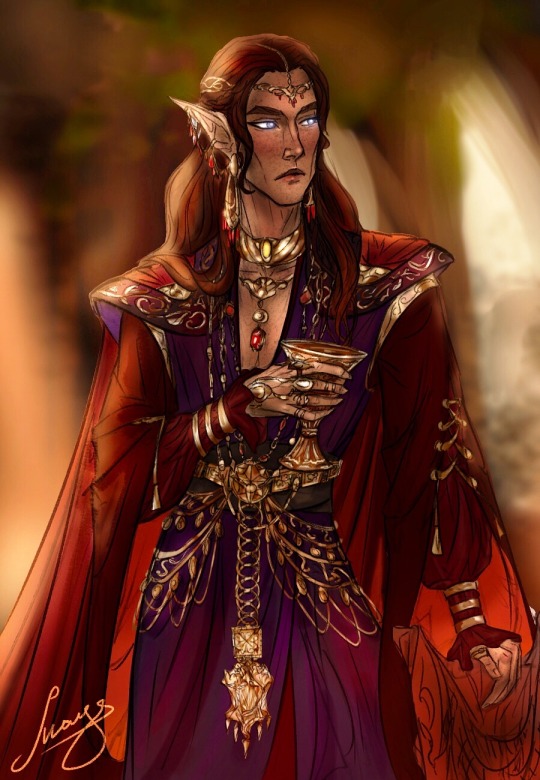
caranthir the dark
943 notes
·
View notes
Text
the silmarillion is wild yall i love it
finrod fucking felagund bites a werewolf to death, instantly dies, and not half a page later i am blasted with the knowledge of sauron's fursona
1K notes
·
View notes
Text

Ëarendil Ardamírë the Mariner
#thats it for the house of fingolfin!#ill make elrond and elros at some point im sure#this one is my favorite hands down#earendil#silmarillion#silmarillion edit#silmarillion moodboard#my edit#i didnt realize he had a mother name but i think its beautiful
34 notes
·
View notes
Text

Maeglin Lómion Lord of the House of the Mole
#my most beloved little guy#i spent way too long on this#but i love it so its okay#maeglin#lomion#silmarillion#silmarillion edit#silmarillion moodboard#my edit
20 notes
·
View notes
Text
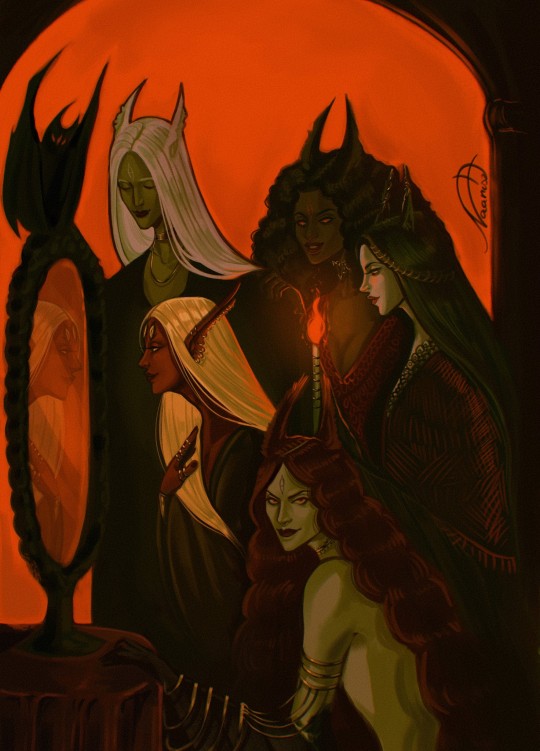
Gorthaur and his vampires
587 notes
·
View notes
Text
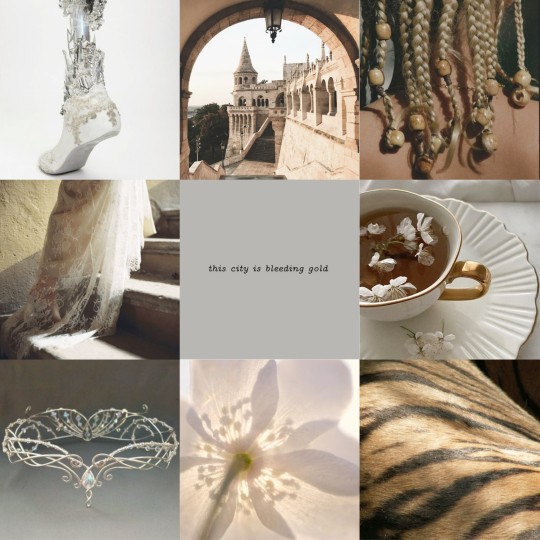
Itarillë Celebrindal Princess of Gondolin
#silver foot means she has prosthetic silver feet of course#also honorable tigress mention#idril celebrindal#idril#silmarillion edit#silmarillion#silmarillion moodboard#my edit
32 notes
·
View notes
Text

Ereinion Gil-galad High King of the Noldor
#pushing my silver haired gil agenda#also pushing my adopted son of fingon agenda#love this little guy#gil galad#ereinion#silmarillion#silmarillion edit#silmarillion moodboard#my edit
26 notes
·
View notes
Text

little fingon design perhaps :)
203 notes
·
View notes
Photo

a bad boy in the forge guys
this is inspired by the cosplay by @sauronsass I haven’t stopped thinking about
432 notes
·
View notes
Text
Silmarillion concept that has me gnawing on the bars of my enclosure today: all of Elrond's parents are terrifying eldritch beings actually.
Maedhros, with white fire pouring from his eyes, taken from the jaws of death anything but unchanged. Some whisper that he's not elvish anymore, not since his captivity. They can never quite agree on what that makes him, exactly.
Maglor, with a voice no elf ever should've had, beautiful and terrible and powerful enough to shake the mountains. Sailors along Middle-Earth's west coast whisper of a sea wraith, some horrible siren that roams the beaches on the darkest nights.
Earendil, a man made an elf, a star, a maia if some are to be believed. Slayer of dragons, guardian of the void. Someone who's spent so along around the Silmaril and the Ainur that some of that power lives within him now.
Elwing, a skin-changer with a voice and a laugh that sound like they were taken from a bird's throat. A witch who lives in a lighthouse, where the animals flock and the plants grow strangely. None of the Amanyar would admit to being scared of her, but few will venture in sight of her odd little realm.
And then there's Elrond, ring-bearer, Lord of Rivendell, kind as a summer.
Well, let's just say it probably helps that no one is expecting him to be normal. Or elvish. Or entirely comprehensible.
#yes this is good#maglor's description is perfection#Maedhros#elrond#maglor#earendil#elwing#silmarillion
749 notes
·
View notes
Text
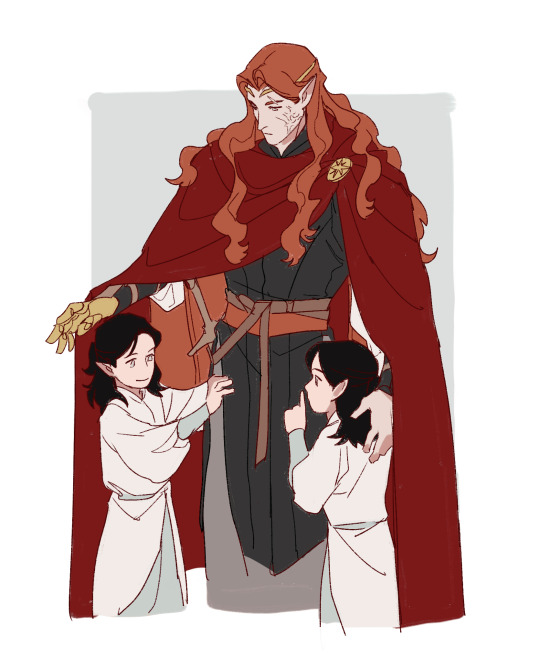
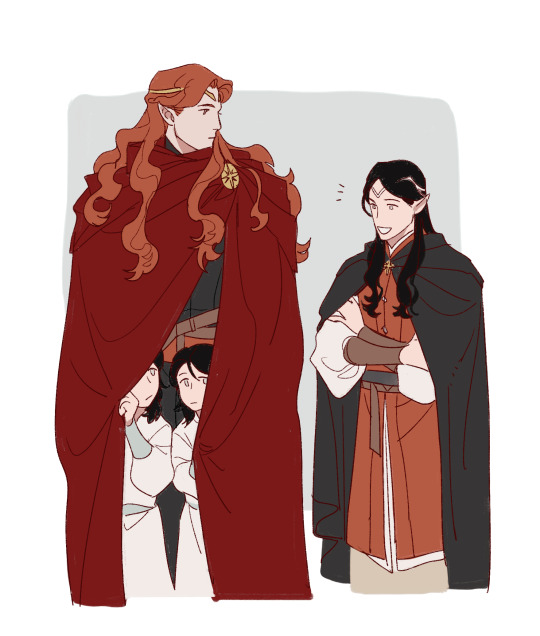

hide and seek
1K notes
·
View notes
Text
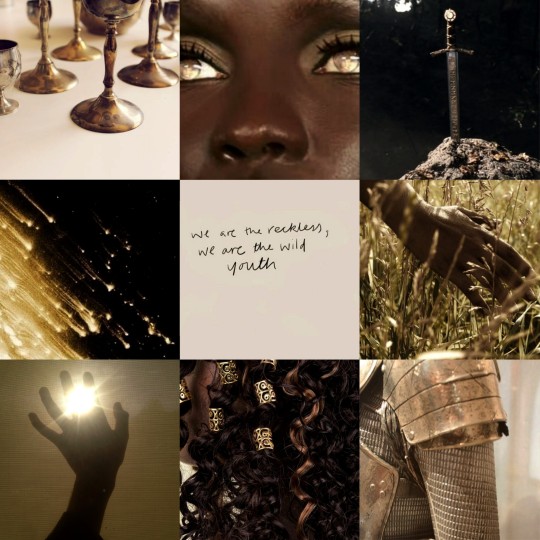
Arakáno the Impetuous Prince of the Noldor
#i refuse to leave argon out#even if i have little hcs about him#i saw someone say they associated him with the color yellow#so thank you for that inspiration#argon#arakano#silmarillion#silmarillion edit#silmarillion moodboard#my edit
19 notes
·
View notes
Photo


vaguely inspired by this beautiful nan elmoth fic that is perfect and everything I love about this terrible family, I just had to draw them after reading that ;u;
1K notes
·
View notes
Text

Irisse Ar-Feiniel the White Lady of the Noldor
#my girl!!!!!#i am very happy with this one#aredhel#silmarillion#silmarillion edit#silmarillion moodboard#my edit
41 notes
·
View notes
